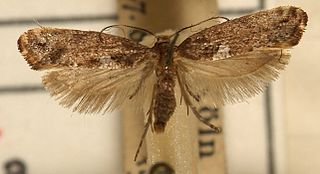
The Acrolepiidae are a family of moths known as false diamondback moths. In modern classifications, they are often treated as a subfamily (Acrolepiinae) of the family Glyphipterigidae.

The Plutellidae are a family of moths commonly known as the diamondback moths, named after the diamondback moth of European origin. It was once considered to have three subfamilies: Plutellinae, Praydinae, and Scythropiinae. Praydinae was later elevated to its own family, Praydidae, while Scythropiinae has variously been moved to Yponomeutidae or also elevated to its own family.

The leek moth or onion leaf miner is a species of moth of family Acrolepiidae and the genus Acrolepiopsis. The species is native to Europe and Siberia, but is also found in North America, where it is an invasive species. While it was initially recorded in Hawaii, this was actually a misidentification of Acrolepiopsis sapporensis.

Acrolepiopsis is a genus of moths in the family Acrolepiidae.
Acrolepiopsis sapporensis is a moth of the family Acrolepiidae. It is native to Asia, where it is found from China and Mongolia to Russia, Korea and Japan. It is an introduced species in Hawaii, where it was initially misidentified as Acrolepiopsis assectella.
Acrolepiopsis postomacula is a moth of the family Acrolepiidae. It was described by Shōnen Matsumura in 1931. It is found in Japan
Acrolepiopsis delta is a moth of the family Acrolepiidae. It was described by Sigeru Moriuti in 1972. It is found in Japan.
Acrolepiopsis suzukiella is a moth of the family Acrolepiidae. It was described by Shōnen Matsumura in 1931. It is found in Japan.
Acrolepiopsis leucoscia is a moth of the family Acrolepiidae. It was described by Edward Meyrick in 1927. It is found in the central United States, from Texas north to Illinois, Missouri and Ohio.
Acrolepiopsis californica is a moth of the family Acrolepiidae. It is found in western California, western Oregon and Alberta.
Acrolepiopsis heppneri is a moth of the family Acrolepiidae. It is found from Connecticut and New Hampshire in the east, south to Tennessee, Alabama and Mississippi, and west to Illinois.
Acrolepiopsis brevipennella is a moth of the family Acrolepiidae. It was described by Sigeru Moriuti in 1972. It is found in Taiwan.
Acrolepiopsis chirapanthui is a moth of the family Acrolepiidae. It was described by Sigeru Moriuti in 1984. It is found in Thailand.
Acrolepiopsis clavivalvatella is a moth of the family Acrolepiidae. It was described by Sigeru Moriuti in 1972. It is found in Japan.
Acrolepiopsis japonica is a moth of the family Acrolepiidae. It was described by Reinhard Gaedike in 1982. It is found in Japan.
Acrolepia moriuti is a moth of the family Acrolepiidae. It was described by Reinhard Gaedike in 1982. It is found in Japan.
Acrolepiopsis orchidophaga is a moth of the family Acrolepiidae. It was described by Sigeru Moriuti in 1982. It is found in Japan.
Digitivalvopsis paradoxa is a moth of the family Acrolepiidae. It was described by Sigeru Moriuti in 1982. It is found in Japan and the Russian Far East.
Acrolepiopsis persimilis is a moth of the family Acrolepiidae. It was described by Sigeru Moriuti in 1974. It is found in Japan.
Acrolepiopsis nagaimo is a moth of the family Acrolepiidae. It was described by Yasuda in 2000. It is found in Japan.


